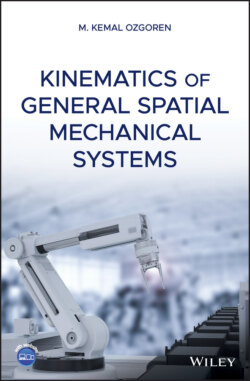Читать книгу Kinematics of General Spatial Mechanical Systems - M. Kemal Ozgoren - Страница 23
1.6.2 Cross Product and Skew Symmetric Cross Product Matrices
ОглавлениеConsider the same two vectors and , which are expressed by Eqs. (1.40) and (1.41) as resolved in the reference frame . Their cross product can be expressed as
(1.47)
On the other hand, according to Eq. (1.25),
(1.48)
Hence, Eq. (1.47) becomes
(1.49)
Equation (1.49) implies that
(1.50)
By using the definition of εijk given by Eq. (1.26), Eq. (1.49) can be worked out to what follows:
(1.51)
Upon comparing the coefficients of the basis vectors of on each side of Eq. (1.51), the following column matrix equation can be written.
(1.52)
Equation (1.52) can be written again as follows by factorizing the column matrix expression on its right side:
(1.53)
Furthermore, Eq. (1.53) can be written compactly as
(1.54)
In Eq. (1.54), is defined as the cross product matrix (cpm) corresponding to the column matrix . When Eqs. (1.53) and (1.54) are compared, it is seen that happens to be a skew symmetric matrix generated from the column matrix .
Considering an arbitrary column matrix , the corresponding skew symmetric matrix is generated by means of the ssm (skew symmetric matrix) operator as described below.
(1.55)
The inverse of the ssm operator is the colm (column matrix) operator, which is defined so that
(1.56)
Coming back to the cross product operation, Eqs. (1.47) and (1.54) imply the following mutual correspondence, which shows how the cross product of two vectors can be equivalently expressed by using the matrix representations of the vectors in a reference frame such as .
(1.57)
